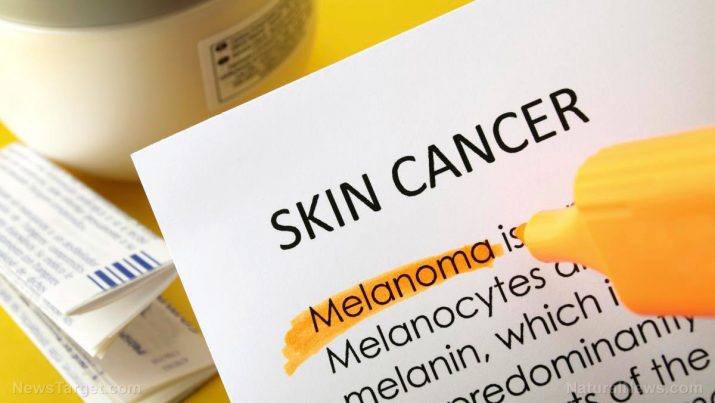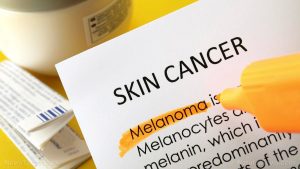
Nodular melanoma – causes, side effects and treatments at NaturalPedia.com
Thursday, May 24, 2018 by Zoey Sky
http://www.naturalpedia.com/nodular-melanoma-causes-side-effects-and-treatments-at-naturalpedia-com.html

Nodular melanoma develops in the skin cells that produce melanin, the pigment that gives skin its color. This form of cancer is a subgroup of melanoma, the most dangerous form of skin cancer.
Nodular melanoma is the second most common type of melanoma in the U.S. This sub-type of melanoma makes up of about 15 percent of all melanoma cases. This melanoma sub-type is the most aggressive form of skin cancer.
Nodular melanoma is also called:
- Cutaneous nodular melanoma
- Malignant melanoma of the skin, nodular type
- NM

Known side effects of nodular melanoma
The side effects of nodular melanoma usually include:
- Asymmetry — A nodular melanoma is usually asymmetrical, especially when compared to a normal mole.
- Border — Unlike normal moles with smooth edges and well- defined borders, cancerous moles can have fuzzy borders and uneven edges.
- Color — A nodular melanoma often has a strange color, and it can appear as a blackish-blue or reddish-blue bump. Other nodules may have no color or are flesh-toned (amelanotic nodules).
- Diameter — A skin lesion larger than six millimeters in diameter, especially one that keeps growing, could indicate melanoma.
- Elevation — Nodular melanoma often appears as a nodule (dome-shaped growth) on the skin. Take note of increased elevation of any skin bumps, which is a warning sign for melanoma.
- Firmness — Nodular melanoma sites are usually very firm to the touch and they don’t move when pressed.
- Growth — Nodular melanomas often grow very quickly. While freckles or moles develop and stop growing after several weeks, those that keep growing after two or three weeks could be melanoma.
Risk factors for nodular melanoma may include:
- Exposure to ultraviolet radiation from the sun and tanning beds.
- Having dysplastic nevus syndrome.
- A past history of melanoma or if one or more of your family members had melanoma.
- A weak immune system.
Body systems harmed by nodular melanoma
Advanced cases of nodular melanoma may cause complications if it has metastasized beyond the skin, such as to the lymph nodes and other organs.
Organs that are commonly involved in metastasis include:
- The brain
- Bones
- The gastrointestinal tract
- The liver
- The lungs
Food items or nutrients that may prevent nodular melanoma
The following foods or nutrients can help prevent nodular melanoma:
- Cruciferous vegetables — Vegetables like broccoli, cauliflower, and kale can help fight skin cancer.
- Curcumin — The main component of turmeric, curcumin has anti-cancer and anti-inflammatory properties that can help prevent the growth of many cancer cells.
- Flax seeds — Flax seeds are full of omega-3 fatty acids that can help prevent skin damage. The fatty acids act as antioxidants when the skin is exposed to UV radiation from the sun, which generates free radicals.
Treatments, management plans for nodular melanoma
In the early stages, nodular melanoma is treated with surgery. The procedure removes the melanoma along with some of the healthy skin around the melanoma.
A healthcare professional can also suggest a lymph node biopsy to check if cancer has spread to the lymph nodes. Melanoma that has spread to the lymph nodes or internal organs requires other treatment methods like:
- Chemotherapy
- Immunotherapy
- Radiation
- Targeted therapy
Where to learn more
- Common melanoma procedure may not be effective or safe, medical journal warns
- Melanoma breakthrough: Natural fruit and vegetable substance stops skin cancer cells
- Melanoma (skin cancer) found to be easily prevented with low-cost Vitamin B-3
- Niacin (vitamin B3) can prevent melanoma, scientists confirm
- Prevent Melanoma Naturally
Summary
Nodular melanoma develops in the skin cells that produce melanin, the pigment that gives skin its color. This form of cancer is a subgroup of melanoma, the most dangerous form of skin cancer.
The side effects of nodular melanoma usually include the abnormal growth of nodules that are asymmetrical, firm, and have a strange color.
Advanced cases of nodular melanoma may cause complications if it has metastasizes beyond the skin, such as to the lymph nodes and other organs.
Cruciferous vegetables, curcumin, and flax seeds can help prevent nodular melanoma.
In the early stages, nodular melanoma is treated with surgery. Melanoma that has spread to the lymph nodes or internal organs requires other treatment methods like chemotherapy, immunotherapy, radiation, and targeted therapy.
Sources include:
Tagged Under: Tags: nodular melanoma





